|

When God first made the world, He looked at the bare and barren
hillsides and thought how nice it would be to cover them with some kind of beautiful tree or flower. So he turned to the
Giant Oak, the biggest and strongest of all of the trees he had made, and asked
him if he would be willing to go up to the bare hills to help make them look more
attractive. But the oak explained that he needed a good depth of soil in order
to grow and that the hillsides would be far too rocky for him to take root.
So God left the oak tree and turned to the
honeysuckle with its lovely yellow flower and beautiful sweet
fragrance. He asked the honeysuckle if she would care to grow on the hillsides and spread her beauty and fragrance
amongst the barren slopes. But the honeysuckle explained that
she needed a wall or a fence or even another plant to grow
against, and for that reason, it would be quite impossible for
her to grow in the hills.
So God then turned to one of the sweetest and most
beautiful of all the flowers - the rose. God asked the rose if she would care to
grace the rugged highlands with her splendour. But the rose explained that the wind and
the rain and the cold on the hills would destroy her, and so she would
not be able to grow on the hills.
Disappointed with the oak, the honeysuckle and the rose,
God turned away. At length, he came across a small, low lying,
green shrub with a flower of tiny petals -some
purple and some white. It was a heather.
God asked the heather the same question that he’d asked the
others. "Will you go and grow upon the hillsides to make
them more beautiful?"
The heather thought about the poor soil, the wind and the
rain - and
wasn’t very sure that she could do a good job. But turning to God she replied that if he wanted her to
do it, she would certainly give it a try.
God was very pleased.
He was so pleased in fact that he decided to give the heather some
gifts as a reward for her willingness to do as he had asked.
Firstly he gave her the strength of the oak tree
- the bark of the heather is the strongest of any
tree or shrub in the whole world.
Next he gave her the fragrance of the honeysuckle
- a fragrance which is frequently used to gently
perfume soaps and potpouris.
Finally he gave her the sweetness of the rose
- so much so that heather is one of the bees
favourite flowers. And to this day, heather is renowned especially for
these three God given gifts.
Introduction
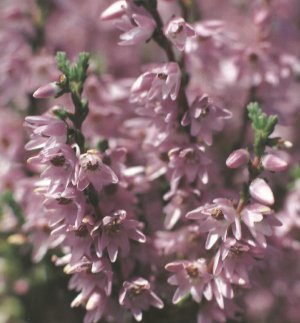 Heather,
the name most commonly used for this plant, is of Scottish origin,
presumably derived from the Scots word HAEDDRE. Haeddre has been
recorded as far back as the fourteenth century, and it is this word
which seems always to have been associated with ericaceous plants. Heather,
the name most commonly used for this plant, is of Scottish origin,
presumably derived from the Scots word HAEDDRE. Haeddre has been
recorded as far back as the fourteenth century, and it is this word
which seems always to have been associated with ericaceous plants.
The origination however is obscure, and
the variations are many. Hader is found in Old Scottish from 1399,
heddir from 1410, hathar from 1597 (although this form of the word may
also be seen in place names dating back to 1094) and finally heather
from 1584.
The botanical name for the Heath family
is Ericaceae, which is derived from the Greek 'Ereike’, meaning
heather or heath. The name is generally, and more properly reserved for
the most widespread of the Heath family Calluna vulgaris, (Calluna from
the Greek ‘Kallune’ - to clean or
brush as the twigs were used for making brooms and vulgaris from Latin,
meaning common.)
However the plant is sometimes also
referred to as Ling - derived either from the old Norse ‘Lyng’ or
from the Anglo Saxon ‘Lig’ meaning fire and referring to use as a
fuel.
Whatever the exact origin, one thing is
certain. Heather moors cover a vast amount of Scottish countryside. With
approximately 2 to 3 million acres of Heather Moors in the East and only
slightly fewer in the South and West, Heather is without doubt one of
Scotland’s most prolific and abundant plants.
A Plant in Abundance
There are a number of reasons why
heathers are so abundant with such a wide distribution. Firstly, the
plant’s reproductive capacity is high with seeds produced in very
large numbers.
Each tiny heather flower has 30 seeds, so
it is quite possible for one large plant to produce up to 150,000 seeds
per season. Small and light, the seeds are readily dispersed by wind and
insects, with the germination period lasting up to six months. This long
period is advantageous to the heather as it means there will be reserve
seedlings to take over if the first seedlings should fail.
Soils
Most heather seeds are normally shed
during November and December, with germination proving most successful
on soils with a pH of between 4.5 and 7.5 (although it is better on
soils tending to the lower end of this scale). But Heather is a very
versatile plant. It readily adapts and thrives in soils which are not
only acid, but also those which are poorly supplied with the mineral
elements normally essential to plant growth. Heather can survive in many
soil types, from those which are peaty with a high water content to
those which are free draining and relatively dry.
Grazing
Despite repeated grazing, heather is
relatively resistant to feeding cattle and sheep. With reserve buds
readily replacing those which have been cut back by the animals, this
hardy plant is really only damaged and destroyed when grazing becomes
excessive.
The hardiness of heather is demonstrated
by its ability to flourish despite recorded temperature extremes. At
ground level, temperatures have been recorded in Strathspey as low as
-32°C (-18°F) in winter and as high as 38°C (100°F) in summer.
Life expectancy of heather is approx.
40-50 years.
Heather Burning & Regeneration
One of the most common and effective ways
of managing heather clad land is the age old method of burning. Heather
burning or ‘Muirburn’, as it is called in Scotland, was, and indeed
still is, necessary for a variety of different reasons.
Originally the process was used not only
to prevent tall shrubs and trees taking over the moor - limiting the
number of older Heather plants which were tall and woody with few young
shoots. But it was also used to create open spaces of land which made it
difficult for preying wolves and foxes to approach domestic herds
unseen.
Now however, heather burning is primarily
used to create the conditions necessary for uniform regeneration of
young heather plants - encouraging high reproductivity of edible new
shoots which are essential to animals and birds dependant upon heather
for survival. Grouse shooting employs many people and brings in valuable
revenue in sparsely populated areas of Scotland.
Burning, as you might expect, is
restricted by law.
In order to cause as little disruption
and damage as possible to both nests and wildlife, the period for
burning in Scotland currently begins in October and lasts until 15th
April. Traditionally however most burning is carried out in Spring,
although some estates maintain that regeneration is better after burning
in the autumn. A saying from North Uist, which has been passed down
through generations, refers to the heather burning which had to be done
in a bad season;
‘Is fearr deathach a’ fhraoich, na
gaoth a reodhaidh’
(Better is the smoke of the heather
than the wind of the frost.)
After burning almost all of the above
ground parts are destroyed. But reserve buds at the base of the stems,
which have been shielded by earth and moss, are protected from the heat
and give rise to new growth the following season. This is known as
vegetative regeneration, with the new growth, referred to in Gaelic as
Mionaa (Meanbh) Fhraoch.
However, this is not the only
regenerative process. Another, although somewhat slower way, is by seed.
Germination of heather seed occurs in the gaps between the burnt plants
- usually where there is a moist seed bed and fluctuating temperatures.
Heather in the Food Chain
Domestic and Wild Animals.
Although few
animals rely on just one food source, many depend
significantly on heather for survival. - Red Deer, Rabbits and Hares, to
name but a few. And it is the heather’s young shoots with which most
of these animals supplement their diet.
One look at a typical example of a food
chain shows just how important heather is in the cycle of moorland life.
Heather shoots.. eaten by caterpillars..
in turn eaten by Meadow Pipit.. preyed upon by Hen Harrier.
At their best, the shoots provide
important minerals such as calcium, phosphorus, nitrogen, magnesium and
potassium, with their nutritional quality determined by the particular
soil quality in that area.
The shoots may be grazed throughout the
year. In winter, the green shoots are eaten followed by the new green
shoots in May. In summer the flowers are eaten, in bud and bloom, along
with the seed heads. And in autumn, even the seed capsules help to
sustain wildlife on the moor.
The Red Deer browse heavily on the
heather, particularly in the winter months when other food is hard to
find. The Roe Deer also graze on the plant, preferring to stay in the
longer heather. Even the Reindeer which were introduced into the
Cairngorm area in the 1950’s, have also come to rely on this popular
food source. Other ‘nibblers’ include Mountain and Brown Hares who
require the young heather for browsing, and rank heather for cover.
Rabbits living on moorland also enjoy young shoots.
According to the Scots National
Dictionary the Wild Cat was also referred to as the Heather Cat.
Of course domestic animals too, such as
cattle and sheep, also benefit from grazing on heather - in areas which
have been specially designated and managed solely for this purpose.
Cattle use the heather to supplement
their winter diet of hay, turnips and manufactured foods. ‘Teck' is
the name used in Shetland to describe the long heather which was used as
fodder. However it is perhaps, the hardiest of domestic breeds which is
the main beneficiary - the Blackface sheep. For many years to the
present day, sheep farmers have taken their sheep to the heather to give
the resultant lamb ‘that special flavour’. Indeed the Blackface
Sheep Breeders Association is pushing hard to have the pure-bred ‘Blackface
Lamb from the Heather', officially recognised as one of Scotland’s
gourmet tastes, comparable with grouse, venison, whisky and salmon.
There are, however, drawbacks as the
following extracts from "The Scots National Dictionary"
outline: Heather Blindness — a disease of sheep.
Contagious opthalmia is a specific
disease of sheep that is common to most sheep-raising countries,
including Scotland, where it is often referred to as "heather
blindness".
Heather Cling - a disease
prevalent among sheep that have been grazing too long on heather.
Heather Claw - A dog’s dew claw,
which is apt to catch in heather with resulting pain, and is therefore
often cut off.
Heather Clout - Also in reduced
form Clu.
The fettock, joint or ankle, the external
and posterior part of which is protected by two horny substances, which
we call heather-clouts.
A Natural Habitat for Birds
The bird most associated with heather is
the Red Grouse, sometimes referred to as ‘The Heather Bird’. The
Gaelic term for the male bird is Coilech-Fraoch, the Heather Cock, with
the female equivalent being Cearc-Fraoch, Heather Hen.
Apart from nesting time when the bird
feeds primarily on insects and grubs, the Grouse will feed on young
heather shoots. Using grit to grind up the hard fibrous heather in it’s
gizzards, the bird is able to turn much of the lignin and cellulose,
(the woody part of the plant), into usable energy. So even in heavy
snows when the heather can still be seen sticking up through the icy
cover, there will be no lack of energy to maintain life. Indeed, this is
why grouse are seldom found starving during deep snows.
Breeding tends to be more successful on
more nutritious heather.
Of course, Heather is more than just a
food source. Heather is also a natural habitat for the hundreds of
different insects, animals and birds all of whom are inter-dependent on
one another.
Providing nesting sites, shelter and
protective cover from predators there are many different types of bird
to be found thriving on the moor.
Red Grouse: Relies on heather not just
for food but also as a protective cover from predators such as the
Golden Eagle and Peregrine Falcon. In Caithness, it is common to see
bunches of heather tied to the top of deer fences which warn these and
other low-flying birds, to take evasive action!
Black Grouse: The best stocks of this
bird are to be found on a moor with a mixture of scrub, tall heather,
bogs, shorter vegetation and farmland. The hen chooses thick heather for
her nest and then moves her chicks to damp ground with rushes, tall
heather, bog myrtle and scrub. Known as the Heather Cock, this bird
consumes the Heather Beetle in great quantity.
Ptarmigan: This bird is normally found on
higher slopes, but in severe winters it will come downhill in search of
the young shoots.
Capercaillie: The Turkey Sized
Capercaillie uses pieces of heather or pine needles to cover its eggs
until its clutch is complete.
Golden Plover: This bird with its
beautiful, plaintive cry nests in the short heather.
Dotterel: Like the Golden Plover and a
member of the Plover family, this bird makes its nest on a carpet of
prostrate heather, high in the Cairngorms.
Lapwing: Sometimes referred to as Peewit
or Green Plover, this bird can be found in short heather close to the
grassland of nearby crofts and farms.
Curlew: For me, Spring has arrived when
the beautiful bubbling calls of this bird can be heard as it glides back
from wintering at the coast to its nesting site in the long heather.
The Common Snipe: Sometimes referred to
as the Heather Bleat(er), gets its name from the sound made by the male
with its tail feathers in flight - mainly during courtship.
Ring Ouzel: Known as the ‘Heather
Blackie’, this bird is very much the ‘Mountain Blackbird’ and
makes its nest from coarse grasses, heather and mud.
The Meadow Pipit: Also known as the
Heather-Cheeper.
The Heather Lintie: Also referred to as
the Twite or Mountain Linnet breeds on the moors and open ground.
The Heather Peeper: Another name for the
Common Sandpiper.
The Heather-Cun-Dunk: A sea bird, either
the Goosander or the Northern Diver.
Golden Eagle: this magnificent bird
constructs its nest, or eyrie, from twigs of heather and preys on
moorland creatures such as Red Grouse and Mountain Hares.
Other birds of prey which are associated
with the heath include the Buzzard, Peregrine Falcon, the Merlin, Hen
Harrier and Short Eared Owl.
Insects
Heathers are affected relatively little
by pests. However there are certain types of insects which can be found
living on the plant. These include the Heather Gall Midge (Wachtiella
ericina) and the Heather Beetle (Lochmaea suturalis).
Other types of insect to live on the
heather are the Sap Suckers. One such example is the Froghopper,
sometimes referred to as the Spittlebug, because of the froth of bubbles
with which it surrounds itself. These bubbles are created from the sap
of the heather plant and are a familiar sight to many people.
The Emperor Moth is a caterpillar which
feeds on the young shoots. It is camouflaged magnificently with its
green body taking on the exact colour of the heather, whilst the pimples
on its body resemble the colour of the heather flower.
The adult moth has tremendous ‘eyes’
which help to ward off prey as it flies over the heather throughout
April and May. After mating the female flies by night to lay olive-brown
eggs on the heather.
The Northern Eggar Moth is another
caterpillar which is also common on heather moors. feeding, once again,
on the young shoots.
In Banffshire, the Dragon-Fly is better
known as the Heather Bill.
Reptiles
There are a few reptiles to be found
living amongst the heather It is not unusual to see Adders basking in
the sun on hummocks before slithering off to hunt for toads and frogs in
nearby pools. In Caithness, frog tadpoles are called Heather-fish.
Associated Plants
On well drained areas Calluna is
generally accompanied by Erica cinerea (Bell Heather), Tormentil and
Common Milkwort. While on wetter soils, Bell Heather is replaced by
Erica tetralix (Cross-leaved Heath) accompanied by other plants such as
Bog Asphodel and Sundew.
In open pine woods, where the ground
vegetation is heathy in nature with plants such as bilberry, cowberry
and crowberry, and grasses like wavy haired grass and soft grass,
heather is once again a prominent member of the plant community. Even in
the Birch woods where the canopy is light, this versatile plant is not
hindered in its growth and is surrounded with bracken and bilberry.
Carline Heather: The bell heather of
Erica tetralix and Erica cinerea. Used also to describe French Heather,
Fraoch Frangach, by old Perthshire hill-folk.
Cat Heather: This is a name used to
describe various types of heather including Erica cinerea, Erica
tetralix, or Calluna vulgaris.
Dog Heather: This is the Aberdeenshire
name given to the ling heather.
Heather in the Construction of and
Thatching of the Dwelling Place
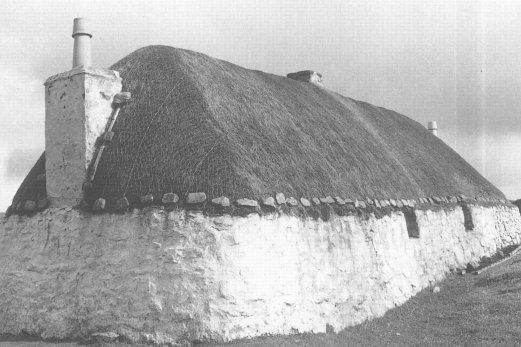
Heather thatch on house in Sidinish, North
Uist.
As one
of the most common and readily available resources in the countryside,
Heather has always played an important role in the traditional
construction of buildings, particularly in areas such as the Hebridean
Islands where construction was strictly determined by the availability
of natural materials and their proximity to the proposed site. As a
result, heather was used to build many dwelling houses, churches and
farmhouses. From walls and thatching to the ropes and pegs which
actually held the building together, Heather proves its versatility once
again.
Thatching with Heather was carried out in
areas as far apart as Shetland in the North and the Island of Arran in
the South West. Buildings which were Heather Theekit - (thatched with
Heather), were generally a better class than those which were thatched
with straw. The old Blackhouses of Lewis for instance which were
thatched with straw and constructed without a chimney or smoke hole, so
as to impregnate the straw with soot for future use as a fertilizer in
the fields were, despite being the possible forerunners of our present
day recycling philosophy, unpopular as they had to be replaced annually.
A Heather roof however, according to J.
Smith in the ‘General View of Agriculture of Argyll (1798), will last
100 years. He tells us that, "Heather roofs are more suited to
Farmhouses, as they, along with our ordinary timber, can be had for a
trifle, last almost as long as slates and give less trouble in
repairs.... It is astonishing that, in a country in which Heather
abounds, these roofs are not more common. They are indeed heavier than
straw roofs; but by making them a little steeper, and placing the
couples a little nearer than ordinary roofs, most of the weight will be
thrown on the walls, which, if made as they ought to be, of stone and
lime, will not feel the burden. It makes a neat warm and durable
roof."
The thatching of these roofs was done by
a ‘heatherer’ and various methods of construction have been
recorded. One method however, which was perhaps in most common use was
to make a covering of divots (thin sods pared off by a spade made
specifically for that purpose) above the wooden framework. Over that was
then spread a thin coat of thatch which was then fastened down by straw
or heather ropes, crossed through each other in a net-like fashion, and
with stones suspended.
Heather divots would frequently be used
to cover the crofters byre and stable roofs and quite often the
crofter's own cottages too. But most often, they were used for covering
potato and turnip pits in winter. The divots were clean and warm, and at
the same time, provided better ventilation than grass sods. Using the
heather divots in this way, laid on like slates, heather side down,
there was no danger of the crops sweating and rotting.
The heather-thatched shielings of Glen
Lyon between 1837 and 1841, were described by Duncan Campbell in his
book, ‘Reminices of an Octogenarian Highlander', as not much to look
at on the outside, but rather substantial and roomy on the inside. Built
of stone, thatched with heather and well constructed for dairy purposes,
recesses, or rather cupboards, were built into the thick walls with
flags for shelves on which milk vessels were placed. Planks were placed
at intervals across the building from one top of the side wall to the
other. And it was here that the cheeses, partly taken out of their
presses, were placed to harden and become partially smoked with the reek
of the peats and the remains of the heather stalks which had been burnt
to the ground the year before.
In ancient times, Churches too were
generally thatched with heather.
The roots of heather served as effective
nails and pegs - used especially for hanging slates. But it was the
small twigs of heather, trimmed and shaped with a knife which were used
to peg down the heather divots in the thatch. Once pegged down, a thick
fringe of heather was arranged to project under the lowest layer of
divots in order to carry rainwater drips away from the roof, clear of
the walls. If however the house did let in water, fesgar, a facing of
straw or heather, would be fastened with boards around the outside of
the house. (Fesgar is also referred to as a strengthening rim for straw
or heather baskets.)
Walls were constructed of Heather-An-Dub
(Heather and daub, sometimes spelt dab) which was a combination of
heather with mud or clay. Built with an inner and outer skin of stone,
the walls had a central core of heather divots. There were many types of
resulting buildings. Basket Houses for instance on the island of Mull
were constructed by wattling together heather and branches of wood. And
in Strathspey, it has been recorded that heather brushwood was used (in
conjunction with wild juniper) in cavity walls of houses to act as
insulation and soundproofing. And talking of insulation, it has also
been used by hill people as insulation against the cold by packing it
down trousers and inside jumpers!!!
ROPES AND LADDER: The Skara Brae
excavation in Orkney revealed a prehistoric village dating back to
around 2000BC. Amongst primitive tools and animal bones they discovered
Seomain fraoich - Heather rope.
Seomain fraoich was made from long stems
of the Heather plant, pulled and woven by hand, and used for a variety
of purposes - from holding down thatch to securing fishing boats. It was
even used in Harris to gather in the seaweed for the production of kelp
which, in turn, yielded iodine essential to the manufacture of glass.
In the Helmsdale area ladders made from
heather ropes, bound together and swung over the cliffs, were used to
give direct access to the shore.
Inside The Home
Even to the present day, crofters and
farmers rely upon heather as an abundant and efficient fuel for their
fires - with the part which is most generally burnt coming from the top
layer of the peat bog. Once cut, stacked and dried it was used for
heating the dwelling place, cooking, drying (especially for drying corn
before it went to the mill), brewing and baking. The small heather stems
were also used as they were found to make excellent ‘kindlers’ for
starting the fire. The crofters even found a use for ‘Heather Birns’
burnt heather - using the short, charred stalks of the plant as writing
instruments!
The Skara Brae excavation in Orkney
revealed evidence of beds in the form of stone boxes, lined with either
heather or straw and dating as far back as 2000 BC. The original heather
beds!
Obviously these beds were developed over
the years with crofters gradually perfecting their construction
techniques using only the longest, straightest and finest stalks of the
young heath. These stalks would be pulled at their highest in bloom and
fragrance, with as little root as possible. Once they had been left to
dry for a few hours to evaporate any dew or accidental moisture, they
would be placed together as thickly and closely as possible, with their
tops arranged uppermost. Inclining a little towards the head of the bed
- which was generally against a wall, the stalks would be held together
at the sides and foot of the bed by logs of wood which had been cut to
appropriate lengths.
Even an outdoor heather bed has its
merits!
And just in case you were wondering about
the support afforded by a heather bed, you might be interested to note
that, according to Mr R. Oldale, Kilchrenan, Argyll, the anvils below
the huge drop hammers in the Sheffield Steel forges were sited on beds
of heather. These heather beds were apparently sufficiently well
cushioned so as to absorb the tremendous impact delivered by the hammers
and thus prevented the anvils from fracturing!
Inside the croft, heather had many
practical uses - from baskets and brushes to pot scrubbers and doormats.
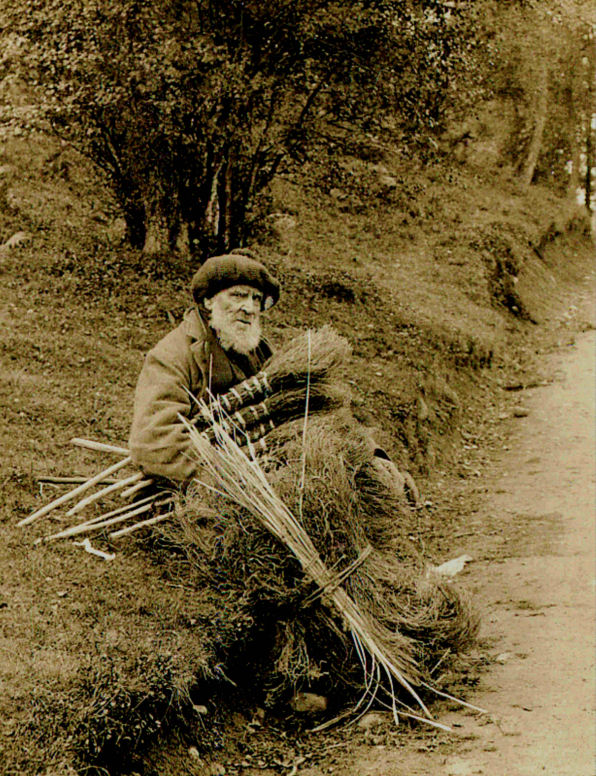
Thanks to Bob at Brooms; Brushes and
Sundries at www.besombinder.com
for the above old picture of a Scotsman selling Heather Brooms.
Heather brooms were made from the long
heather stems which were gathered in spring when they were at their most
pliable. These would then be bunched together and guilloteened to form a
trim broom.
Many types of besoms and brooms were made
in this way, and the art of brush making became a small, rural craft
industry. Types of brushes and besoms varied, depending on locality, and
were sold roundabouts by Heather Jennys and Heather Jocks (the nicknames
for the men and women who sold heather goods). Indeed a great trade was
long practised in the making of heather goods as, until around 1860,
there were few modern brushes to be found on an ordinary farm.
A Curing Heather Cow was the term used to
descibe a broom made of heather twigs whilst a Heather Range(r)/ Reenge
- sometimes referred to in Orkney as a Heather Scratter -was the name
given to a bunch of straight heather stems cut to equal lengths and
bound firmly together for use as a pot scrubber or for brushing the flue
of a chimney. In-fact, to this day, Chimney Cleaners in Lewis still use
bunches of heather tied to to the end of ropes as they insist that it is
the only way to get the job done properly.
Heather doormats were also common in the
croft. Mats would be specially made for the kitchen using long, thin
heather stems. They would be woven in many different patterns with the
bottom side rough where the clipped ends were concealed and the upper
side smooth. In Islay, these mats which were woven from young heather
were known as ‘peallagan’.
Baskets were made all over the highlands
and had many uses round the croft. Using long heather stems, they were
made either to be carried on the human back or as pack saddles which
were carried by horses. They were also hung on walls for storage. The
Saalt (Salt) cuddle from Shetland, is just one example of such a basket
which was hung beside the fire and used to keep salt dry.
Of course there were many other different
types of basket each with a specific role. The Mudag (Wool Basket) for
instance, was specially made to hold wool before carding, and the Maisie
- a large meshed panier of bent rope or heather, was used for carrying
sheaves and peats.
In Orkney, one particular form of basket
was called a ‘Heather Cubby'. These baskets were made in various forms
but the most common one was woven from long, fine, straight heather
stalks, not rough or crinkly, and was used for carrying turnips from the
shed to the byre for the cattle. Carried on the back, they were also
used to bring peats inside from the stack. Another type of basket was
the ‘Sea Cubby’ - so called because it was specially used to carry
home fish. Other baskets including the Heather Caissie (from Orkney) and
the Heather Wuddie/Widdie were made to hold fish, fishing line and bait.
Even the lobsters of the Hebrides which were sent to London where they
were in great demand, travelled packed in heather.
Examples of these and other utensils can
all be seen at the Highland Folk Museum at Kingussie.
Uses of Heather Outdoors
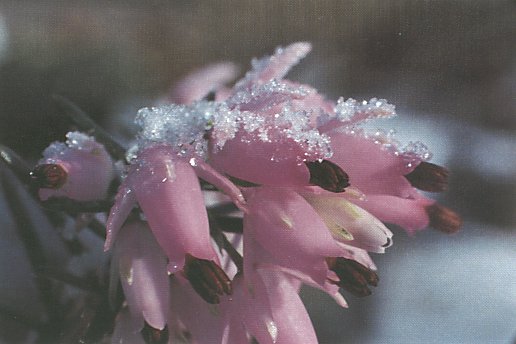
Abundant and readily available, heather,
with its twiggy nature and durable characteristics - even in bog
conditions, was often used in the making of roads, tracks and footpaths.
It was mainly laid as an intermediate layer between a base of brushwood
and a surface of gravel. And it was this method, which was reportedly
used, in laying tracks across Rannoch moor.
In Mediaeval times, the otherwise useless
parts of a sheep’s fleece, known as ‘daggings’, were laid and
mixed with heather to form footpaths across the heath. This ancient
practice is currently experiencing a revival, with daggings by the
hundred-weight being airlifted by the RAF to reinforce foundations along
the popular walkways of the Cairngorms.
Depending on the drainage, lighter soils
can be prone to ‘silt up’. To avoid this happening, the tops of old
heather would be placed in the bottom of a trench to act as a field
drain. Another way in which heather was useful as a ‘conservation
method’ was in the production of stabilising banks. These banks, in
conjunction with planting marram grass, would be made from long heather
twigs and used to stabilise dunes - a method employed, particularly in Holland. Used for protecting sheep
and other animals in the winter months, sectioning them off into
particular areas, fences would be made from the longest, most supple
stems of rank heather, intertwined between stakes and posts.
Heather branches were very often used to make walking sticks,
particularly in Colonsay where the rich peaty soil on the east of the
island made ideal growing conditions. Two such specimens were sent to
Edinburgh University. One branch was measured at 6ft. whilst the other
was a mere 4ft. in height!
Salmon Fishing
Heather was often burned as a fuel for cooking and heating. But it
was also used for lighting - Salmon
Lighting that is. The following extract from ‘Days and Nights of
Salmon Fishing in the Tweed’ by William Scrope, descibes how heather
was used in an age old technique for catching salmon.
"We went to the barn and tied up twae heather lights frae a
bunch or twae which I had gead the miller lad to dry in the kiln ten
days before. They may talk o’ ruffles and birk bark baith, but gie me
a good heather light, weel dried on the kiln for a throat o’ the Queed."
Bunches of heather which had been thoroughly dried were placed inside
a special basket-like carrying device. Once set
alight, this ‘heather torch’ would be held at the water’s edge
where the flickering flames and lights would attract the fish from the
low water, (known as ‘burning the water’). The salmon would approach
the lights, whereupon they would be speared by a five barbed, long
handled fork, called a "leister". This method of fishing was
legal at the time.
Raising the Sails
A story, taken from a book by John Mowat,
tells of another rather ingenious way in which heather was used by James
Bremmner - a famous ship builder and harbour engineer who was born in
the Parish of Wick in 1784.
"The brig Isabella of Sunderland was
driven on the sands of Dunnet in a storm, and was held fast in the quick
sand. Trenches were dug with a view to floating her, but every becoming
tide refilled them. Mr Bremmner was a little puzzled and, turning to his
foreman said, "John have ye no plan?"
On receiving an answer to the negative,
he sharply replied, "Then awa to the hill and poo heather!"
Not knowing to what purpose this was meant, the man quietly submitted
and was soon reinforced by a number of women and children from the
neighbourhood, organised for the same purpose. On the tide receding, he
built up the sides of the trenches with the heather, a plan which
effectually prevented them from filling in again. Anchors were put out
astern and as the tide flowed, he summoned the whole neighbourhood to
pull the vessel off with tackles. The Isabella soon slipped into the
water"
From Floor Tiles to Jewellery
Shortly after the second World War, a
restriction on the use of wood was initiated. Ground level houses were
unable to have the normal timber floor boards and were mainly
constructed of concrete or stone. But these floors were hard and cold
underfoot, and they had no ‘give’. So, in answer to this problem, a
small factory employing three to four people, was set up at the side of
Loch Lomond, in Dumbartonshire. The factory then set about the
production of floor tiles made from the woody heather stem. The
resultant tiles were extremely hard wearing and lasted a good length of
time.
The tiles were made by compressing the
heather stems together into blocks using a special bonding agent. Then
they were cut transversely, producing the resultant floor tile.
When eventually restrictions on the use
of timber were relaxed, and normal building techniques resumed,
production of the heather floor began to dwindle as it proved too
expensive to produce.
However the basic technique which had
been developed by this small factory of compressing the heather stems
was essentially a good one, and was put to a more cost effective use by
the jewellery industry.
Initially small blocks were recessed into
wood and staghorn to form brooches and pendants. Then a method of dying
the stems was developed which resulted in more colourful and interesting
jewellery. In time, the small craft workshop became more and more
sophisticated in techniques, design, production and marketing.
Paint Colourings and Dyes
Born in 1772, Dugald Carmichael, a
little-known botanist returned to his native Scotland after a lifetime
of exploring the world in search of new plants. Dugald’s other great
love, besides botany, was painting. But he had great difficulty finding
the exact colours he required, so he started to use the natural pigments from plants to
colour his paints. And it was to the tops of the heath that he turned to
for the colour yellow.
Of course the art of using natural pigments for colouring has been
around for centuries with crofters relying on the heather to dye their
wool and cloth.
A Traditional Recipe for the Dying
of Wool
Gather the tops of the (Barr An Fhraoich) Heather. Gather when they
are young and green, and growing in a shady place. Place a layer of wool
and heather alternately on the bottom of the pot until the pot is
filled. Then add as much water as the pot will hold. Put on the fire to
boil, but do not allow to boil dry. The wool will dye a lovely yellow
colour which is a good basis for green when indigo is added. If a moss
green is require, add gall apples and iron mordant towards the end of
dying. Purple and brown tints can be obtained by using old heather tops.
If wanted for winter use, the tips of the heather plant should be
picked just before they come into flower. If it is to be used fresh, it
can be gathered as long as the flower is in bloom.
The resultant dye is a mordant dye which means the fibre requires
special preparation before it can absorb the colour. The treatment is 4oz alum and 2oz
cream of tartar to every 1 lb of wool.
A Taste of Heather
HEATHER ALE - A Galloway Legend
From the bonny bells of heather,
They brewed a drink Lang Syne
Was sweeter far than honey
Was stronger far than wine.
R.L. Stevenson
Heather has been used over the years to flavour many different foods
and drinks. Little is actually known about the early beverages of
Scotland. However, many tales are told of brewing ales and wines from
heather flowers. One such brew was known as Heather Crap Ale.
TRADITIONAL RECIPE FOR HEATHER ALE
Ingredients: Heather, hops, barm,
syrup, ginger and water. ‘Crop the heather when it is in full bloom,
enough to fill a large pot. Cover the croppings with water and set to
boil for one hour Then strain into a clean tub. Measure the liquid and
for every dozen bottles add one ounce of ground ginger, half an ounce of
hops and one pound of golden syrup. Bring to the boil again and simmer
for 20 minutes. Strain into a clean cask. Let it stand until milk-warm
and then add a teacupful of good barm. Cover with a coarse cloth and let it stand till next day Skim carefully and pour the liquid
gently into a clean tub so that the barm is left at the bottom of the
cask. Bottle and cork tightly The ale will be ready for use in 2 or 3
days and makes a very refreshing and wholesome drink as there is a good
deal of spirit in heather’
As recently as 1993, an AlIoa brewery went into production of Heather
Ale using an ancient recipe.
TRADITIONAL RECIPE FOR HEATHER WINE.
1 ½Ibs. Heather Tips (in full bloom)
1 Gallon water
3-4 lbs. Sugar (according to sweetness desired)
2 Lemons
2 Oranges
1 teasp. dried yeast
1 teasp. yeast nutrient.
Cover heather with the water and boil for one hour. Strain off liquid and measure. Restore
to one gallon, and add sugar. Stir until completely dissolved. When the
temperature drops to 70F, add yeast and nutrient. Leave for 14 days.
Then strain into fermentation jar, and when fermentation ceases, strain
and bottle. Keep for at least six months!
HEATHER TEA
Gather the flowering heather and after breaking off the hard woody
pieces, spread it in a cool open space and leave for approximately 12 -
16 hours. This should, in theory, allow a slight wither to take place -
but with heather having a hard leaf, this is not too noticeable.
Put the heather into a liquidiser and
bruise and break-up the heather as much as possible. After this spread
thinly in a cool place and leave for a minimum of 3 hours to allow a
ferment to take place. This should be apparent from a darkening of the
mash. After this, put into an oven, temperature 200-250F until the
heather is dry and crisp. The tea retains its misty mauve colour and
looks attractive. Used on its own, the product gives a thin liquor.
Mixed in equal parts with ordinary tea however, it gives a much stronger
flavoursome brew. This is a proper tea - not herbs masquerading as tea.
Tinkers Tea
Trout fishermen having a day on the loch
use the following method to make tea - they fill the kettle with loch
water and take it to the shore, a sprig of heather and tea is then
deposited in the kettle. Next, set old dry heather under and make a
mountain of heather over the kettle and ignite. By the time it has burnt
out the tea is ready and has a heathery flavour. This method was
described to me by Mr George Sproat, 4 Rockfleld Road, Tobermory, Isle
of Mull.
On the Isle of Skye they had a very
simple remedy for tea which had been ruined by smoke from the fire. The
solution - a sprig of heather simply placed in the cup!
Heather Whisky
It is said that some of the finest brands
of whisky derive some of their most delicate flavours from the heather.
At the Highland Park Distillery, in
Kirkwall, Orkney, there was a peculiarly shaped timber building,
referred to as the ‘Heather House’. This was where heather, which
had been gathered in the month of July when the plant was in full bloom,
was stored. Carefully cut off near the root, and tied into small faggots
of about a dozen branches each, the heather was used on the peat fire to
help dry the malt and impart a delicate flavour which, was claimed, to
give Highland Park Distillery its unique taste.
It is interesting to note that in former
times the wooden containers for fermentation, known in whisky
distilleries as ‘washbacks’, would be cleaned using heather besoms.
And when new stills were installed, bundles of heather would be placed
in the water and boiled in order to sweeten the still before the first
distillation took place.
In the nineteenth century and possibly
even earlier, illicit stills were used to make whisky - in broad
daylight. The crofters were able to do this because, by gathering up and
using old stumps of burnt heather, they could make a fire without smoke,
and so not raise suspicion!
Heather Honey
There is no other honey quite like
heather honey.
Quite different even physically from all
other honeys, pure heather honey is sought after by the epicure and
commands a high price. Bright golden brown with a pronounced and
characteristic flavour, the harvest of heather honey is the premier
honey crop in this country.
In some respects, gathering the honey
from heather is easier than gathering honey from any other flower
source. There is little likelihood of bees swarming when taken to the
heather, routine inspection of the hives can be dispensed with and the
expectation of a good harvest is reasonably certain - dependent on good
weather and no early frosts.
Transportation of the hives to the
heather moors is generally undertaken between the end of July and the
12th of August, although this can vary according to the season. However
it is advisable to try to catch the best of the Bell Heather and Cross
Leaved Heath Crops when they are in the first flush of bloom.
Transportation of the bees is best carried out either in the cool of the
evening or the early hours of morning. This reduces losses by
suffocation.
Due to the flowering structure of the
heather plants, where there are numerous flowers on spikes, close to one
another in vast expanses of bloom, a considerable amount of honey can be
collected in a comparatively short time. Being bell-shaped, the flower
is easily entered with the nectar readily available to the visiting bee.
The corolla tubes of these small flowers are approximately 2-3mm long
with the nectar being concealed at the flowers base. This is easily
sought out and collected by the honey bee’s spoon-tipped tongue which
is approximately 6mm long. The nectar is converted to honey by the bees
themselves.
Bell Heather honey is a thinner honey
with a port wine colour and a strong characteristic flavour, whilst
Cross Leaved Heath Honey is much thinner and lighter in colour.
Weather Predictions
Even predictions in the weather have been
associated with heather. It is said, in Scotland, that an extremely rich
blossom on the heather during August and September, is followed by
severe weather in winter. Whilst another widely held belief,
particularly throughout the south of the country and the Cheviot range,
is that the buming of the heather ‘doth draw doon the rain’!
Plant Badges of the Clans
As already mentioned, Heather can be
used, in conjunction with deerhorn, silver and pewter, to make colourful
and effective jewellery. But another important decorative use for
heather was as a plant badge of the clans. This was used long before the
tradition of heraldic badges with the appropriate chiefs crest, straps,
buckles and mottos.
Referred to as ‘Heather Taps’, these
natural plant badges were worn by the Highlanders in the seventeenth
century, if not before, and were placed behind the crest in the bonnet.
Heather (Fraoch) was the emblem of the clans MacAlister, MacDonell,
Shaw, Farquharson, Maclntyre and Mac Donald, with white heather (Fraoch
GeaI) pertaining to MacPherson.
It is said that the chiefs of the clan
Donald carried into battle, as an emblem of their race, a bunch of wild
heather hung from the point of a quivering spear.
Another way in which heather was used
decoratively was in the form of dirk handles. Made from the stems and
roots of the plant and carved deeply in Celtic designs these were worn
on kilts around the sixteenth and seventeenth centuries.
The Healing Properties of Heather
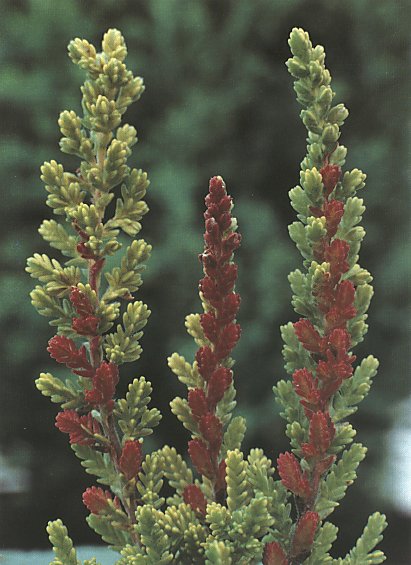 The healing properties of heather have
been recorded as far back as the middle ages, with books on other herbs
and their uses dating even further back to the seventh century. The healing properties of heather have
been recorded as far back as the middle ages, with books on other herbs
and their uses dating even further back to the seventh century.
A German book, written in 1565, describes
the famous doctor Paulus Aegineta as using the flowers, leaves and stems
to heal all types of sores incuding ulcers - both internally and
externally.
Fuchs wrote in 1543 that the healing
effect of the plant could ease insect bites. Whilst Matthioulos, who
lived round about the same time, used the plant in drug form to heal
snake bites, eye infections, infections of the spleen and in preventing
the formation of stones in internal organs.
Nicolas Alexandre, a Benedictine monk,
wrote that boiling heather stems and drinking the liquid for thirty
consecutive days, morning and evening, was sufficient to dissolve kidney
stones. He added, that the patient should also bathe in the Heather
water.
Heather has even been found to help
nursing mothers produce more milk. Schelenz wrote in 1914 that Heather
was a household remedy for all sorts of illnesses and complaints.
However by the turn of the century, heather, in medical terms was
generally associated with the prevention and treatment of stones in the
bladder and kidney area.
Since 1930, Heather, referred to by the
medical profession as Herba Callunae, has been acknowledged by many
doctors and chemists as effective against arthritis, spleen complaints,
formation of stones, stomach and back ache, even paralysis and
tuberculosis. This remarkable plant, which is quite safe for use by
diabetics, is also known to be good for sore throats, gout, catarrh and
coughs. Some say it even cleanses the blood getting rid of exzema and
fevers.
Medical herbalists, to this day, use
Calluna vulgaris in the treatment of certain disorders. Containing
tannin and several other components, it is used particularly in the
treatment of cystitis (bladder infection), as its action is diuretic and
antimicrobial.
In the mountain regions of Europe the
plant is still used to make a linement for arthritis and rheumatism by
softening the herb in alcohol.
Honey for Hay Fever
Pure Heather Honey is recommended for hay
fever sufferers.
Heather was not only associated with
curing illnesses - it was, according to the Scots National Dictionary,
also used figuratively, to describe ailments and other peculiarities
common to country folk. HEATHER ILL This was the description used
to describe constipation of the bowels. HEATHER LAMP A springy
step common among people accustomed to walking over heathery ground. The
term ‘heather lamping’, refers to lifting feet high when walking -
sometimes called a ‘heather step’. Walking with a step high and wide
was described as walking with ‘heather legs’. HEATHER HEADED Sometimes
referred to as ‘heather heidit’, this is the description given to
someone with a rather dishevelled head of hair - and indicates a rustic
or country background. HEATHER GOOSE This was the term used to descibe a
dolt or ninny. HEATHER PIKER This
term was a contemptuous epithet for a person living in a poverty
stricken or miserly way. HEATHER WIGHT The
name given to a Highlander. HEATHER LOWPER A hill dweller,
countryman — known as a Heather-Stopper in Perth. HETHER MAN, HATHER
A heather seller. Also found purporting to be a term in free
masonry.
A Heather Garden
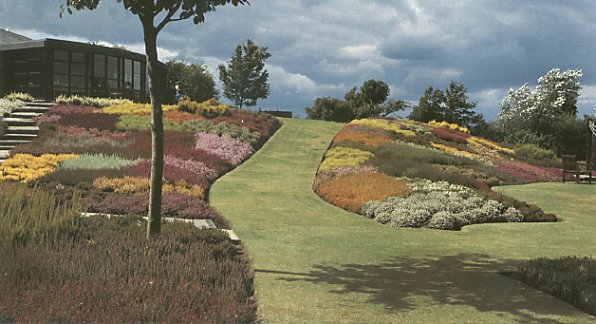
As a plant with so many advantages for
the present day gardener, it will come as no surprise to find that
Heathers are more popular than ever! Providing colour all year round
with foliage and flower, heathers are evergreen and will thrive for many
years. Inexpensive to purchase and relatively easy to grow, heathers,
once established, will provide a weed free garden which requires the
minimum of maintenance.
Easy to propagate, heathers are also
relatively free from diseases and pests. Small wonder then, that
landscape projects large and small, from industrial sites and motorways
to housing developments and car parks, make great use of this plant.
Until recently little scientific work has
actually been carried out on the hybridisation of heathers, but yet,
hundreds of different cultivars are now available from specialist
nurseries. Many of these cultivars have been found in the wild as ‘chance’
seedlings, perpetuated by vegetative propagation. Other cultivars arrive
as ‘chance’ seedlings in nurseries - as sports or mutations in
gardens. Each with their own distinctive qualities.
For instance, plants brought back from
the remote island group of St. Kilda, (approximately 50 miles west of
the Outer Hebrides and 100 miles from the mainland), are extremely dwarf
and spreading. They remain so even in cultivation, their characteristics
having been developed to cope with the extreme exposure experienced on
the islands.
Cultivars discovered quite by chance
include one which was found growing as a sprig on Calluna ‘County
Wicklow’. ‘County Wicklow’ has double pink flowers, but this
cultivar had double white flowers. The sprig, found in a garden in
Argyll, has since been propagated successfully and is now catalogued
under the name Kinlochruel. (A selection of cultivars are listed towards
the end of this section.)
The heather gardener has many cultivars
to choose from and one glance at the photographs in this page should
help to convince even the most reluctant gardener that, together with a
few conifers and shrubs, an attractive and easily maintained garden can
be easily achieved.
The Heather Society
Founded in 1963, to assist in the
advancement of horticulture, and in particular, the improvement of, and
research into the growing of heaths, heathers and associated plants.
It publishes a Year Book and three
Bulletins annually to keep members up to date. It maintains a slide
library, provides free technical advice and arranges local and an annual
national conference.
For details of membership contact: Mrs
A. Small, Administrator, Denbeigh,
All Saints Road, Creeting St. Mary,
IPSWICH, SUFFOLK 1P6 8PJ.
Affiliated Societies
North American Heather Society.
Secretary: Walter H. Wornick, Highland
View, P0. Box 101, Aistead, New
Hampshire 03602, U.S.A.
Nederlandse Heldevereniging ‘Erlcultura’.
Secretary: Mr. J. Dahm, Esdoornstraat
54, 6681 ZM Bemmel, Netherlands.
Gesellschatt der Heldefreunde.
Chairman: Fritz Kircher, Tangstedter Landstrasse 276, 2000 Hamburg 62,
Germany.
SPEYSIDE HEATHER CENTRE
Was
originated in 1972 - by David and Betty Lambie with the intention of
being Scotland’s Heather Specialists. Located appropriately in the
heart of Speyside in the central Highlands of Scotland amidst glorious
scenery the award winning centre now attracts aprox 85,000 visitors
annually.
Any enquiries the reader may have should
be addressed to:
Speyside
Heather Garden & Visitor Centre
Skye of Curr
Dulnain Bridge
Inverness-shire,
Scotland PH26 3PA.
Tel: 01479 851359
International: +44 1479 851359
Fax: 01479 851396
Email: enquiries@heathercentre.com

The Lambies
Our thanks to the author of this
book, David Lambie, for letting us take part of his book to publish
here. The whole book is available for purchase at their web site and
includes details of the many heathers available and how to grow them as
well as suggested heather garden layouts. When you visit their centre
make sure to visit their Clootie Dumpling restaurant!
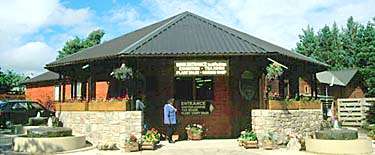
Speyside
Heather Garden & Visitor Centre
The Heather in Lore, Lyric and Lay
By Alexander Wallace (1903)
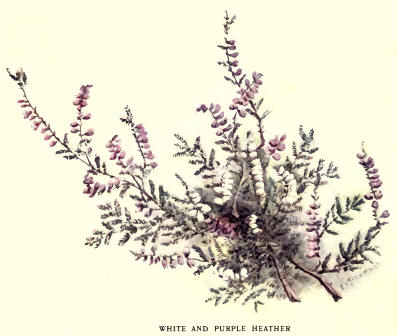
RUSKIN, in one of his friendly lecture-talks on art, with the
sympathetic spiritual perception and originality of thought
which characterize his unique genius, says: "Now, what we
especially need for educational purposes, is to know, not the
anatomy of plants, but their biography—how and where they live
and die, their tempers, benevolences. distresses and virtues."
The quaint sentiment voiced by the great philosopher many years
ago is somewhat significantly in harmony with this dawning time
of a simpler and brighter understanding of humanity and of
nature. And could we find for such a flower biography a subject
more entrancing, so seductive, almost eerie, so plaintively
sturdy, so instilled with romance, with patriotism and with
pathos—as the Highland Heather?
There dwells, perhaps, no
solitary plant or flower in the sheltered garden or in the
lonely wild, whose family ties show no modest record hidden
somewhere in the stately annals of history; but the crude fact
of history, like a tale that is listlessly told, has little
power to charm where lack the flash and glow of emotional ardor;
and so I have invoked to my humble biographical narrative of
this bonnie floral hermit on our bleak majestic Highlands, that
ancient patron Muse of Scotia's departed minstrels—the Spirit of
Caledonia. We learn from the histories of the vegetable
kingdom that Calitma vulgaris—the generally accepted botanical
term for Heather—has a wide distribution throughout European
countries, and in other parts of the world. But so closely has
the word Heather become associated with Scotland, that whenever
we hear it spoken, or see it written, the fancy instinctively
roams to the "land of brown heath and shaggy wood," the beauty
of whose stem mountains, softened with their autumnal vesture of
purple and brown blending in every-varying and never exhausted
tints, has baffled the painter's genius, enchanted the poets
vision, and inspired monarch and peasant alike to sing its
praises. The Heather enters into the literature, the poetry,
the lyrics, and into the home life of the Scottish people, to a
degree unsurpassed by any other plant in the history of nations
and the wonder is that its own interesting story has not before
been told in some complete form. Scotland and the heather are
inseparable; the flower derives its inheritance of unique
renown, and somewhat, too, of rugged temperament, from the
Caledonian mountain wild which has become so characteristically
its home; thus it is in its identity with the land of Bums that
I wish principally to consider it.
For the purpose of a
clearer elucidation of the history and utility of the plant
itself, however, it has been thought necessary to go beyond
Scotland's borders; still it is believed that this further subject
matter presented will be welcomed with interest in localities
wherever Scotsmen gather—and by those for whom all things
Scottish have a fascination.
A more opportune time, perhaps,
could not have been chosen in which to tell the absorbing
nature-story of the Heather than this year, the centenary of the
council at which Science, in its discernment, removed from the
plant its ancient and ill-deserved appellation of Erica, and
clothed it with its present designation of Calluna, so much more
truly expressive of its unique beauty and charm.
"Co attempt
has been made to enter fully into the botanical or cultural
details connected with the plant. These have been treated only
in a casual manner: still, it is hoped sufficient information
has been given to prove serviceable. The effort has been rather
to cull from the multitude of references to the Heather
abounding in Scottish and other literature, and to weave the
sprays thus gathered into a literary garland the beauty and
attractiveness of which shall lie in the depth of the sentiment
pervading it, and in the aroma of patriotic love that it
exhales. Defects in the treatment of the subject may assert
themselves to the critical reader. No one will be more conscious
of these imperfections than is the author; but, in the language
of an old writer, for faults of omission and commission, "I
referre me wholy to the learned correction of the wise; for t'el
I wote, that no treatise can alwayes be so workmanly handled but
that somewhat sometyntes may fall out amisse. contrarie to the
mmdc of the vryter, and comrade to
the expectation of the reader; wherefore my petition to thee,
Gentle Reader, is to accept those my travyles wyth that mimic I
doe offer them to thee, and to take gently that I give gladly;
in so doing I shall thinice my paynes well bestowed, and shall
bee encouraged hereafter to trust more unto thy courtesie."
To the friends who have so willingly and
generously assisted me in the collection of the information
submitted, I tender my sincere thanks. Particularly, in this
respect, am I under obligation to Mr. Robert Cameron, Curator of
the Botanic Gardens, Harvard University: Mr. Jackson Dawson, of
the Arnold Arboretum; Mr. William Falconer, Superintendent of
Allegheny (FL) Cemetery; Mr. George W. Oliver, of the Bureau of
Plant Industry, Department of Agriculture, Washington, D. C; and
Mr. Joseph Meehan, of Germantown, Pa.
Especially am I indebted to Miss Elizabeth
I. Bierstadt, daughter of Mr. Edward Bierstadt, of New York
City, and niece of the celebrated American landscape painter of
that name, for the charming life-like painting of the sprays of
Heather, reproduced from flowers received from Scotland, which
form the frontis. piece to this work.
I also tender my acknowledgments to Mr. H.
C. Dugan, of Aberdeen, Scotland, for photographs of Scottish
mountain scenery.
I send forth
this little volume, the result of some years of painstaking
research during the spare moments snatched from a rather busy
life, as the tribute Of an expatriated Scotsman to the mountain
flower of his home land, hoping that a perusal of its pages may
but deepen the ardor of Scotland's sans and daughters everywhere
to continue to sing, with the best heart and voice at their
command, the praises of their native Heather.
ALEXAND€R WALLACE
New York, December, 12.
Contents
Etymology
Botanical History
Distribution of the Heather
The
Heather Abroad
In America
Cultivation in America
In the British Colonies
In
Australia
In New Zealand
In South Africa
In India
Varieties of the Heather
Symbiosis of the Heather
Economics of the Heather
Heather Thatch
Heather Beds
Besoms and Scrubbing Brushes
Uses in Dyeing
Medicinal Virtue
As a Forage
Plant
Bees and Heather
Miscellaneous Use
Peat Making
Heather Ale
Heather Burning
Heather Bells
in Scottish Scenery
The Magic of the Heather
Heather, the
Martyr's Friend
The Heather as a Clan Badge
Heather Lore
White Heather
Shadow Folk of Heather Haunts
Heather Jock
The Comrade of the Heather
Grouse: The Heather Bird
Chimings of the Heather Bells
Love Among the Heather
At Rest, where Heather Blooms
Heather Lays
A Bit of
Heather
The Bed of Heath
Heather Ale, a
Galloway Legend
Heather Burning
Moorburn
The Wee Sprig o' Heather
Heather Musings
Scotch Heather
My Wee Bit Heather
On a Spray
of Heather
Heather Jock
The Rose Among the
Heather
A Sprig of Heather
The Flowers of
Scotland
A Sprig of White Heather
The
Heather
The Faded Heather
Heath
The Heather at My Door
To a Wild Heath Flower
Scotch Heather
The Heather
Clover and
Heather
The Heather
Songs of the Heather
Among the Heather
The Plaid Among the Heather
The Heather Belt
The Hills of the Heather
The Hielan' Heather
The Hieland Heather
My
Heather Hills
The Land of the Bright Blooming Heather
Sweet Heather Bell
O'er the Muir Amang the Heather
Amang the Braes o' Blooming Heather
When the Heather
Scents the Air
My Heather Land
Poetry and Songs
Quoted from:
Bonnie Auld Scotland
Our Ain
Land
The Land o' Cakes
The Freedom of the
Hills
Know'st Thou the Land?
Hurrah for the
Highlands
The Covenanter's Tomb
Cailleach
Bein-y-Vreich
The Cameron Men
Is Your
War-pipe Asleep?..
The Yellow Locks o' Charlie
Wha'll be King but Charlie?
When Charlie to the
Highlands Came
Shagram's Farewell to Shetland
The Scotsman's Farewell
Farewell to the Land
I'll Loe Thee, Annie
The. Hills of the Highlands
The Chieftain to His Bride
Ca' the Yowes
O'er the Mountain
The Crook and the Plaid
I'll Twine a Wreath
The Heathy Hills
Lass of
Logie
My Highland Cot
Scotland Dear
Scotland's Hills
The Hills O' Gallowa'
Hame
Flowers of the Moorland
On the Hills
Solitude
Send a bit
of heather o'er the sea
To Scotia's sons, where'er they be;
Its bloom will bring to mind
Scenes and faces left
behind,
And anew each heart will bind
To the old countrie.
Send a bit of heather o'er the sea;
Transported back each
heart will be
To fair Scotland's wooded hills,
Hear the
music of her rills,
And the mavis as it trills
In the old
countrie.
Send a bit of heather o'er the sea;
Simple offering though it be,
Prized 'twill be where
fairest flowers
Blossom in their tropic bowers,
Or where
iceberg frowning towers
O'er the sea.
Send
a bit of heather o'er the sea;
A dear remembrance may it be
To the ones now vigil keeping
O'er our soldiers quietly
sleeping;
Send the heather—Scotland's greeting—
O'er the
sea.
—M. CARTER, in Scottish American
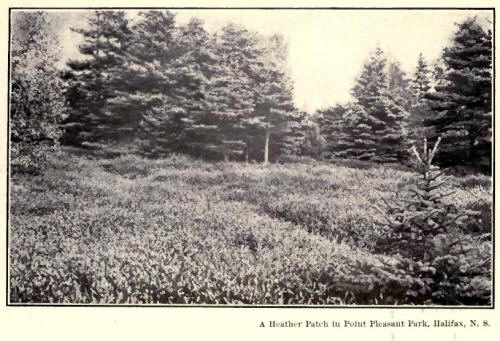
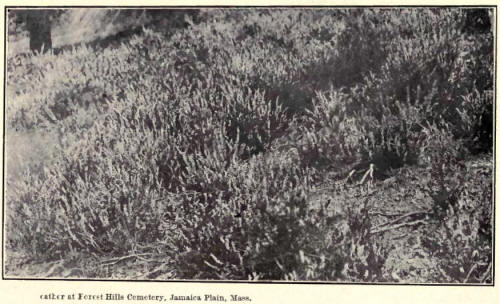
|
